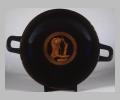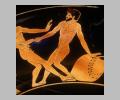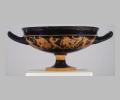| Collection: | Berlin, Antikenmuseen |
| Summary: | Interior: komos (man vomiting, assisted by a boy). Side A: komos. Side B: komos. |
| Ware: | Attic Red Figure |
| Painter: | Attributed to the Dokimasia Painter |
| Context: | Excavated at Capua |
| Date: | ca. 490 BC |
| Dimensions: | H. 14.2 cm., d. 25.5 cm. |
| Primary Citation: | |
| Shape: | Cup |
| Beazley Number: | 203944 |
| Region: | Campania |
| Period: | Late Archaic |
Condition:
The cup is in good condition.
Decoration Description:
Interior: komos, with a man vomiting, assisted by a boy. A bearded man leans on his staff and bends over as he vomits, one hand clutching his stomach. A small, naked boy holds the man's head. A large, shallow bronze vessel with four handles and three legs stands on a low base in the foreground. The bearded man wears a mantle; both man and boy wear wreaths.
Side A: komos. A naked youth plays his flute in the center of the scene, while two other youths and six men drink and dance on either side. He plays with his weight thrown back on his right, bent leg, and his cheeks full of air. Under the handle on the far left another naked youth crawls toward the revellers. Next to him is a bearded man playing a barbiton, the fingers of his left hand spread across the strings, his other hand holding a chord attached to the instrument. Another bearded man faces him holding a large, wreath-bedecked amphora, his mantle flung over his shoulders and his right arm raised. Behind him is the flute-player. To the right of the flutist a bearded man dances holding his staff, his mantle draped over one shoulder and his head turned toward the music. The naked youth next to him faces left, a skyphos in one hand, his other hand raised, palm outward. Behind him a naked man, bearded and balding, dances holding a pitcher. Another naked, bearded man dances facing him, a kylix in one hand. Behind him lies a large amphora, again decorated with a wreath, a which a third man, bearded and balding, crouches, as if looking inside to check the wine level.
Side B: komos. A young girl plays a flute while four youths and two men sing and dance. The scene divides into two groups, with three youths around the krater on the left, and two men and a youth dancing to the flute to the right of the flute-player, who stands in the center of the scene. There is a wreath around the large krater. The youth on the far left holds high a kylix and a skyphos, Next to him dances a youth holding a kylix, a mantle thrown over one shoulder. The third youth dips into the krater, a kylix held in his other hand. The flute-player, who has short, gold-brown hair, stands in the center facing right, her cheeks puffed out as she blows on the flute. She wears a chiton and a fillet. To her right dances a balding, bearded man holding a kylix, a mantle draped over his arms. The man behind him bend over to grab the handle of a large, wreath-bedecked amphora lying on the ground. He holds a kylix in his other hand, and a flute-sheath made of animal skin is draped over his arm. The youth on the far right walks to the right, but turns his head and stretches an arm to the left, his other hand grasping the stem of a kylix. Some of the men have hair on their chests and stomachs. All the figures on both sides wear wreaths with flowers clustered over the forehead.
Shape Description:
For the shape, see Bloesch 142, Acrocup no. 2.
Inscriptions:
On the interior, nonsense inscriptions.
Collection History:
The cup was found in Capua in 1871 in a stone 'cubo' together with a bronze ash urn. It was acquired by the museum in 1875.
Sources Used:
Other Bibliography:





